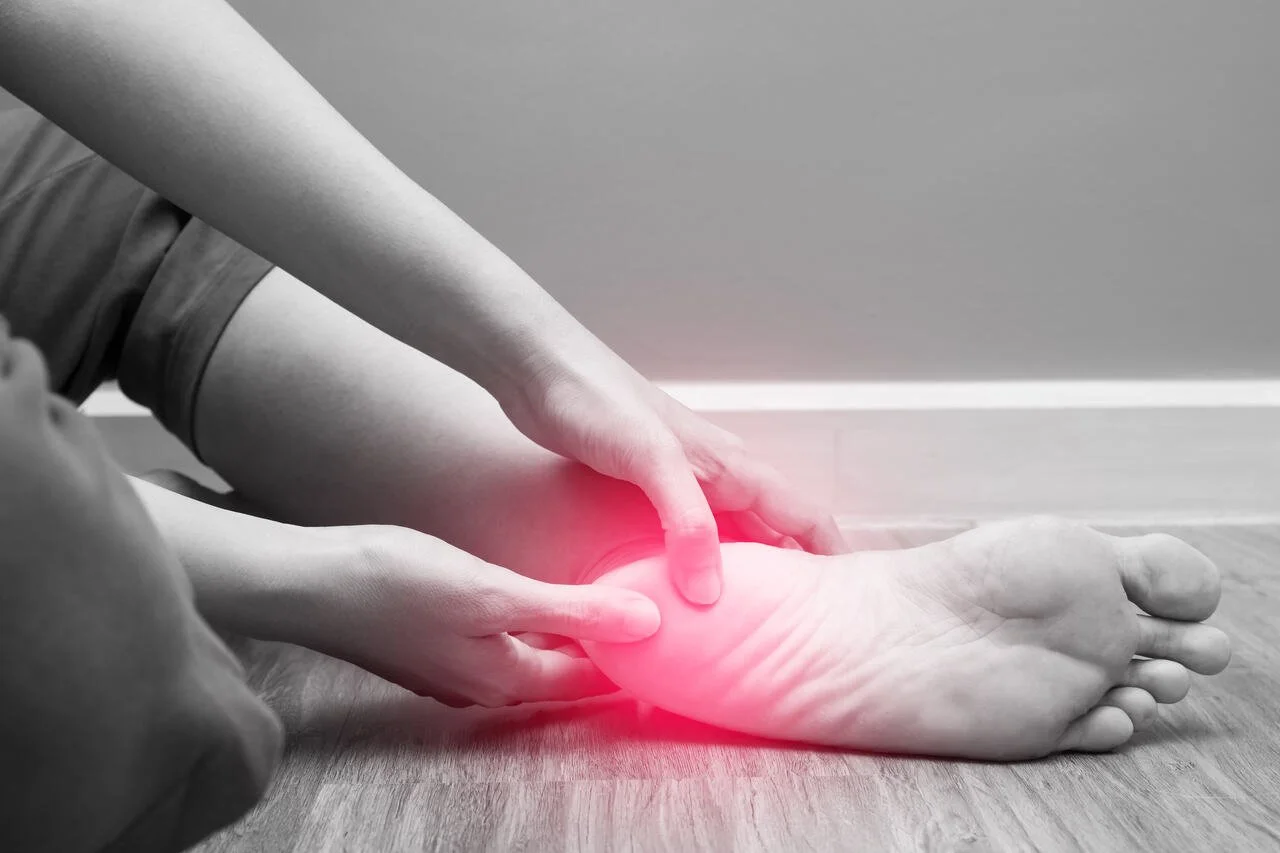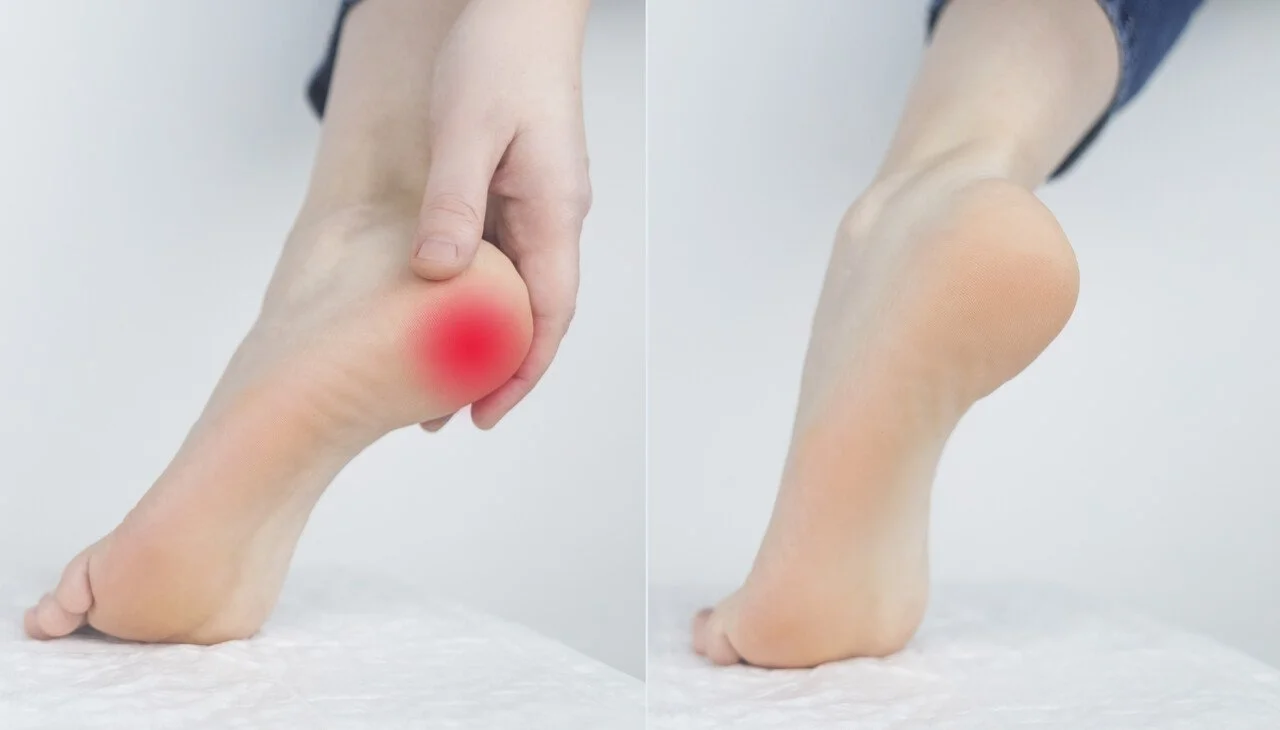The Role of Physiotherapy in Plantar Fasciitis Recovery
Plantar fasciitis is a common yet painful foot condition that impacts the quality of life for many individuals. This blog post delves into the symptoms, causes, and, importantly, the role of physiotherapy in treating plantar fasciitis.
What Is Plantar Fasciitis?
Plantar fasciitis is a condition involving a thick connective tissue located on the bottom of your foot called the plantar fascia. The plantar fascia runs from your heel to the balls of your feet and helps support your arch. It also has an important role in walking, running and jumping activities helping with shock absorption.
What Are the Symptoms of Plantar Fasciitis?
The most common symptom of plantar fasciitis is a sharp and stabbing pain located at the bottom of the heel which can travel through the arch towards the toes.
This sharp pain is usually greatest in the morning, especially with your first few steps. As you start to move and your tissues warm up the pain goes away or decreases.
Pain can also result after exercise or after prolonged inactivity such as sitting or non weight bearing.
What Causes Plantar Fasciitis?
Although the exact causes are not fully understood, plantar fasciitis is typically caused by repetitive strain or overuse of the plantar fascia resulting in inflammation and pain.
Some common risk factors include:
Incorrect walking/running/jumping mechanics
Weakness in foot and ankle muscles
Overuse or excessive physical activity
Flat feet or high arches
Tight calf muscles
Improper footwear
Obesity
Age
Can Physiotherapy Treat Plantar Fasciitis?
Physiotherapy is an effective treatment for plantar fasciitis. Treatment involves a combination of stretches, strengthening exercises, manual therapy techniques and correction of running, walking and jumping mechanics.
Physiotherapy aims to address the underlying factors that contribute to plantar fasciitis, such as tight calf muscles, weak foot muscles, improper foot biomechanics and decreased ankle and mid foot joint mobility.
Strengthening exercises focus on improving the strength and stability of the foot and ankle to better support the arch, reduce strain on the plantar fascia and decrease inflammation.
Additionally, manual therapy techniques performed by a physiotherapist, such as joint mobilizations and soft tissue mobilization can help reduce pain and improve flexibility.
Click here to learn how our Anti-Gravity Treadmill can help you correct your walking and running mechanics.
Consistency is key when treating plantar fasciitis. Make sure to stick to your customized plan developed by your physiotherapist to achieve the best results.
What Is the Fastest Way to Relieve Plantar Fasciitis Pain?
While there’s no instant cure for plantar fasciitis there are several strategies you can try to alleviate pain quickly:
Active rest: reduce or avoid activities that aggravate your pain, especially high impact activities like running and jumping. For the activities that cause pain, try to make small adjustments to the way you’re moving and see if that helps decrease the pain. For example, if running on a treadmill causes pain try running on a softer surface or in different shoes.
Stretching: reduce tension on the plantar fascia by stretching your calf and the muscles on the bottom of your foot. Keeping your muscles loose will help reduce plantar fascia irritation.
Massage: massage the plantar fascia by using a lacrosse or golf ball and rolling the bottom of the foot. This can be done in a standing or sitting position. Make sure to do this multiple times per day.
Supportive footwear: make sure to wear shoes that match your foot type. If you have flat feet you’ll want a shoe that is more supportive and if you have higher arches you’ll want a shoe that has more cushioning.
Don’t ignore pain: not being able to play the sport you love can be frustrating but be sure to listen to your body. If something is causing you a lot of pain don’t keep pushing because eventually if you push too much you can cause further damage and other issues.
Always remember the 0-10 pain scale we use here at Elevate. 0 = no pain at all and 10 = the worst pain you’ve ever felt. If you’re doing an activity try to keep the pain levels to a 5 or lower. Anything above that and you have to make some modifications.
What Therapy Is Best for Plantar Fasciitis?
The best therapy for plantar fasciitis often depends on the individual's specific circumstances, including the severity of the condition, underlying causes, and personal preferences. However, several therapies have been found to be effective for treating plantar fasciitis:
Physiotherapy: physiotherapy involves a variety of techniques including manual therapy, stretching, strengthening and improving walking and running mechanics. A physiotherapist can create a tailored treatment plan to address your specific needs to help you with your plantar fasciitis.
Massage therapy: massage therapy can be beneficial in managing the symptoms of plantar fasciitis. Massage can help reduce muscle tension and improve circulation which can help to alleviate the pain and discomfort associated with plantar fasciitis.
Specifically, massage therapy for plantar fasciitis may involve techniques such as deep tissue massage, myofascial release, trigger point therapy, cross friction massage and stretching.
Chiropractic: chiropractors can help treat plantar fasciitis by offering a variety of techniques such as performing adjustments to the joints of the ankle and foot which can help improve biomechanics and reduce the strain on the plantar fascia.
Chiropractors can also perform soft tissue techniques such as instrument-assisted soft tissue mobilization (IASTM) to help reduce tissue tension.
Orthotics may also be recommended to provide support and alignment for the feet which can help alleviate symptoms of plantar fasciitis.
Is It Good to Massage the Feet with Plantar Fasciitis?
Massaging the feet can be beneficial for individuals with plantar fasciitis as it can help alleviate pain and discomfort associated with the condition. Massaging the feet can help in several ways:
Relief of muscle tension: Massaging the muscles of the feet and calves can help relax tight muscles and reduce tension, which can contribute to plantar fasciitis symptoms.
Improved circulation: Massage can help improve blood flow to the affected area, which can promote healing and reduce inflammation.
Breaking up scar tissue: Plantar fasciitis can lead to the formation of scar tissue in the plantar fascia, which can contribute to pain and stiffness. Massaging the feet can help break up scar tissue and improve flexibility in the plantar fascia.
Release of endorphins: Massage can stimulate the release of endorphins, which are natural pain-relieving chemicals produced by the body. This can help reduce pain and improve mood.
When massaging the feet to help with plantar fasciitis, it's important to use gentle but firm pressure and focus on areas of tension and discomfort.
Techniques such as deep tissue massage, myofascial release, and trigger point therapy can be particularly effective. However, it's also essential to avoid excessive pressure or over-massaging, as this can potentially exacerbate symptoms or cause further injury.
Additionally, combining massage with other treatments such as stretching exercises, strengthening exercises, and orthotic devices can help maximize the benefits and promote recovery from plantar fasciitis.
If you're unsure about massaging your feet or if you have any concerns about your condition, it's always a good idea to consult with a healthcare professional or a qualified massage therapist for guidance.
What Not to Do with Plantar Fasciitis?
When dealing with plantar fasciitis, there are several things you should avoid to prevent exacerbating symptoms or delaying recovery:
Ignoring the pain: Ignoring the pain and continuing with activities that aggravate plantar fasciitis can worsen the condition and prolong recovery time. It's essential to listen to your body and modify activities to avoid further strain on the plantar fascia.
High-impact activities: Avoid high-impact activities such as running, jumping, or activities that involve prolonged standing on hard surfaces, as these can exacerbate symptoms and delay healing. Instead, opt for low-impact exercises like swimming or cycling that put less stress on the feet while recovering from plantar fasciitis.
Wearing unsupportive footwear: Avoid wearing unsupportive footwear, such as flip-flops or worn-out shoes, as they can contribute to poor foot mechanics and increase strain on the plantar fascia. Opt for supportive shoes with good arch support and cushioning to help alleviate pressure on the feet.
Skipping stretching and strengthening exercises: Neglecting to perform stretching and strengthening exercises can lead to muscle imbalances and reduced flexibility, which can worsen plantar fasciitis symptoms over time. Make sure to incorporate regular stretching and strengthening exercises into your daily routine to maintain foot health and prevent recurrence.
Overstretching: While stretching is essential for relieving tension in the plantar fascia, overstretching or stretching too aggressively can cause further damage. Perform gentle, controlled stretches and avoid forcing the stretch beyond your comfort level.
Ignoring biomechanical issues: Plantar fasciitis can be caused or exacerbated by biomechanical issues such as flat feet, high arches, or improper gait. Ignoring these issues can prolong symptoms and increase the risk of recurrence. Consider seeking professional evaluation and treatment to address any underlying biomechanical issues contributing to your plantar fasciitis.
Click here to book a FREE Discovery visit with one of our therapists to see how we can help you.
Delaying treatment: Plantar fasciitis tends to worsen over time if left untreated. It's essential to seek timely treatment and address the condition promptly to prevent further complications and facilitate recovery.
Self-diagnosing and self-treating: While certain home remedies and self-care strategies can provide temporary relief, it's essential to seek professional evaluation and guidance for an accurate diagnosis and personalized treatment plan tailored to your specific needs.
By avoiding these common pitfalls and following a comprehensive treatment plan, you can effectively manage plantar fasciitis and promote healing. If you're unsure about the best approach for managing your condition, consult with a healthcare professional for guidance and support.
Find Relief from Plantar Fasciitis: Book Your Consultation
Dealing with plantar fasciitis can be a long and frustrating journey. However, with the right approach and professional guidance, recovery is within reach. Physiotherapy offers a beacon of hope, offering tailored treatments that address the root cause of the pain while promoting healing and preventing future occurrences.
If you're in Oakville and struggling with plantar fasciitis, consider Elevate Rehabilitation and Performance. Our expert team is dedicated to helping you regain your footing in life, pain-free. Embrace the path to recovery and take the first step towards a life free from plantar fasciitis pain. Contact us to learn more about how we can elevate your rehabilitation journey and transform your performance.
Questions about Plantar Fasciitis?
See how we can help by booking a FREE 30 minute consultation and get all your questions answered by one of our therapists!




